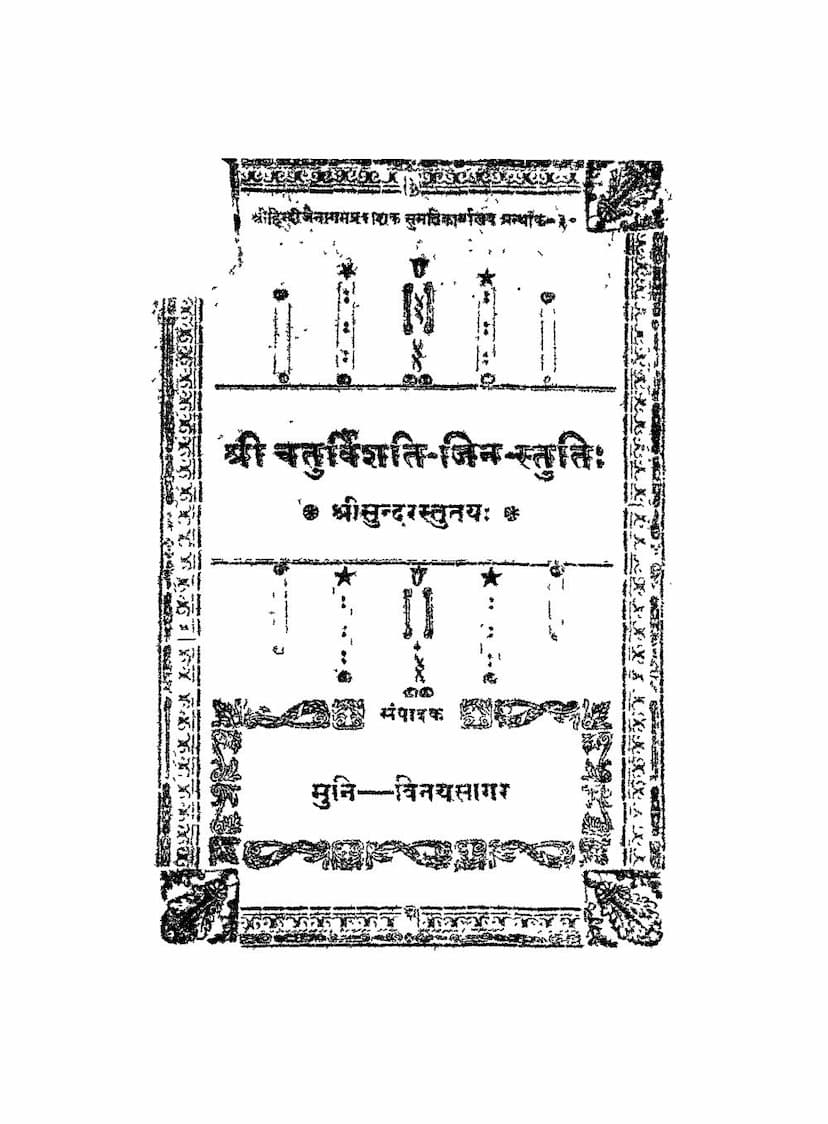Chaturvinshati Jin Stuti
Added to library: September 1, 2025

Summary
This document is a Jain text titled "Chaturvinshati Jin Stuti" (Chant of Twenty-Four Jinas), authored by Vinaysagar. The preface, written by Agarachand Nahata, provides a comprehensive overview of Jain stotra literature and the context of this specific work.
Here's a summary of the key points:
-
Introduction to Stotra Literature: The preface begins by discussing the universal human tendency to venerate and create memorials for virtuous and learned individuals. This veneration manifests in art, architecture, and literature, including biographical works, devotional literature, and hymns (stotras). It highlights the historical development of stotra literature in India, from Vedic hymns to Puranic and Tantric influences, and mentions famous stotras from other religious traditions like Buddhism.
-
Jain Stotra Literature: The text emphasizes the significant place of Jain stotra literature within the broader Indian context. It notes that Jainism naturally reveres its Tirthankaras (spiritual guides). It traces the evolution of Jain stotras, mentioning early works and influential authors like Samantabhadra, Siddhasena Divakara, and Manatunga Acharya (author of the famous Bhaktamara Stotra). The preface notes a significant increase in the production of stotras from the 12th to 15th centuries onwards. It also touches upon the publication efforts of various organizations and individuals to preserve and disseminate these valuable texts.
-
The Author and the Work:
- The author of the "Chaturvinshati Jin Stuti," Pandit Shri Sundar, was a disciple of Harshavimal, who was a disciple of the eminent Kharatara Gachchha Acharya Yu. Shri Jinchandrasuri. Shri Sundar is also known for his works related to Jinchandrasuri and other historical Jain compositions.
- The "Chaturvinshati Jin Stuti" itself is described as a scholarly work adorned with Yamaka Alankara (a poetic device of skillful repetition and variation of words or phrases). Each of the 24 Jin stutis is structured with a specific pattern, often involving the repetition of the second line of a verse in the fourth line with a slightly different meaning. The text mentions the use of various Sanskrit meters like Shardulvikriditam, Upendravajra, Shalini, etc.
- The stutis are organized to praise a specific Tirthankara in the first stanza, followed by verses praising all Jinas, the Jain teachings (Jinvachan), and the guardian deities (Shasan Sevak Devas).
- The preface highlights that this particular work is believed to be the first of its kind to use the Yamaka Alankara in the "Chaturvinshati" format, with Bappabhatta Suri and Shobhan Muni being earlier exponents of similar styles.
- The text is presented with its original commentary (Swopagna Vritti), written by the author himself, which clarifies the meaning and nuances of the verses. This commentary is considered invaluable for understanding the profound philosophical and devotional content.
- The publication of this work is attributed to Muni Vinaysagar, who is commended for his efforts in bringing this rare and important text to light. The preface concludes by thanking Muni Vinaysagar for his contribution.
-
Publisher and Edition:
- The publisher is listed as Shri Hindi Jain Aagam Prakashak Sumati Karyalaya, Kota (Rajputana).
- This is the first edition (Prathama Vritti), printed in Veer Samvat 2411 / V.S. 1904 (Gregorian year 1847).
In essence, the "Chaturvinshati Jin Stuti" is a devotional hymn dedicated to the 24 Tirthankaras of Jainism, notable for its intricate poetic structure utilizing the Yamaka Alankara and its profound philosophical depth, presented with an original commentary by the author, and published through the efforts of Muni Vinaysagar. The preface provides a scholarly context, tracing the lineage of Jain stotra literature and highlighting the significance of this particular work.